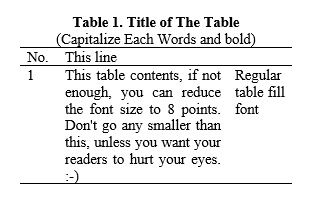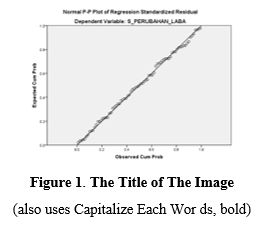Submissions
Author Guidelines
Manuscript Structure
The writing style of the manuscript should be as clear, succinct, and consistent as feasible. Ten to twenty (twenty) pages make up the total amount of pages (including figures and tables). On one side of A4 (210 x 297 mm) paper, manuscripts are written single-spaced. Normal margins, or top, bottom, right, and left margins, measuring 2.54 cm, are required for manuscripts. Times New Roman is the typeface utilised. The introduction, which should cover the creation of the hypothesis and the research objectives if available, is followed by the sections on research methods, results and discussion, conclusion, and references in the article. The manuscript is written in Bahasa Indonesia or English.
Title
Typed in capital at the start of the sentence and lowercase (sentence case) in the left margin (align left), the title should succinctly and clearly state the primary point. A maximum of 18 words in a 14-point font size is the suggested title length.
Abstract
A well-prepared abstract enables the reader to identify the basic content of a document quickly and accurately, to determine its relevance to their interests, and thus to decide whether to read the document in its entirety. The Abstract should be informative and completely self-explanatory, provide a clear statement of the problem, the proposed approach or solution, and point out major findings and conclusions. The abstraction, between 100-200 words, just one paragraph. Abstract consists of issue and focus of community service, subject of devotion, the purpose of community service, methods / approaches / strategies of community service research, and the results of community service (measurable results).
Introduction / Pendahuluan (11 pt, bold)
The introduction talks about the background of the community service activities that were done, that is a description of the situation analysis or objective conditions of the community service subject (assisted community), problems and focus of the service, reasons for choosing the community service subject, and expected social changes or community service goals supported by qualitative and quantitative data, and supported by a review of relevant literature and the objectives of the activities to be carried out. In the background, also explain the contribution of the activities carried out. Sources of information are designated by writing in parentheses: the author's last name and year of publication or using APA Style. Presented in a way that makes it easy to see what inspired this study and what the results should be.
Research Methods / Metode Penelitian (11 pt, bold)
Contains an explanation of the community service collaborative action planning process (community organizing). Here, the topic of community service, location, and participation of assisted subjects in the planning and organizing process are all explained, as well as the techniques or research approaches used to achieve the expected goals and stages of community service activities. Diagrams or flow charts can be used in the planning process and strategies/methods.
Results and Discussion / Hasil dan Pembahasan (11 pt, bold)
Provide a detailed account of the outcomes of the analysis or the community service process, focusing specifically on the solutions to the identified problems. This talk contains a comprehensive overview of all the actions conducted. The current observation data from diverse activities are utilized to develop technical or programmatic interventions aimed at addressing community issues.
The results and discussion section of the research paper aligns with the sequential steps of the research methodology in order to accomplish the objectives stated in the introduction. The inclusion of a picture depicting the service activity is obligatory. The outcomes attained must be quantifiable in order to assess the degree of effectiveness of the conducted actions. The attained outcomes must be juxtaposed with analogous endeavors to assess the pros and cons of the executed service operations.
Table
The table is in the middle. Use Times New Roman and font sizes 8 to 11. Horizontal lines in the middle of the table do not need to be displayed; only display the heading and the very end, and there should also be no vertical lines. Make sure you create the table correctly via the Insert Table menu. Tables should be referenced in the text by writing something like: '... (Tables are written with a capital 'T').

Try not to truncate the table on different pages unless the size exceeds one page. If you have to truncate, don't forget to rewrite the header row for each column, given the same table serial number, and replace the title with Continuation. The table title does not end with a period. Tables do not need to use vertical lines.
Figure
As with tables, make sure each figure has a sequence number and a title. Make the images you use to look like they're professionally made and don't need to be framed. It is better to use black-and-white images.

Conclusion / Kesimpulan (11 pt, bold)
Contains a description of the conclusions of the results of community service in the form of theoretical reflections and recommendations. The conclusion must explain the level of success of the service program that has been carried out (measurable). At the end, suggestions for further community service activities can be added.
REFERENCES
Written using the American Psychological Association 7th edition style, 80% of references must be primary sources, and recommended using the Mendeley application or other reference management application program such as EndNote, Reference Manager, or Zotero. The bibliography does not need to be divided into sections. The number of references in the bibliography is at least 15. The following is an example of how to write a library :
Reference from book:
Sugiyono. (2014). Metode penelitian kuantitatif kualitatif dan R&D. Alfabeta.
Reference from scientific journals:
Artaningrum, R. G., Budiartha, I. K., & Wirakusuma, M. G. (2017). Pengaruh profitabilitas, solvabilitas, likuiditas, ukuran perusahaan dan pergantian manajemen pada audit report lag perusahaan perbankan. E-Jurnal Ekonomi Dan Bisnis Universitas Udayana, 6(3), 1079–1108.
Reference from dictionaries/encyclopedias – print :
VandenBos, G. R. (Ed.). (2007). APA dictionary of psychology. Washington, DC: American Psychological Association.
Reference from dictionaries/encyclopedias – online :
Arcus, D. (2001). Attention deficit / hyperactivity disorder (ADHD). In B. Strickland (Ed.), The Gale encyclopedia of psychology. Diakses dari http://www.gale.cengage.com/
Reference from conference papers or seminar proceedings published – print :
Edge, M. (1996). Lifetime prediction: Fact or fancy? In M. S. Koch, T. Padfield, J. S. Johnsen, & U. B. Kejser (Eds.), Proceedings of the Conference on Research Techniques in Photographic Conservation (pp. 97-100). Copenhagen, Denmark: Royal Danish Academy of Fine Arts.
Reference from conference papers or seminar proceedings published – online :
Tester, J. W. (2008). The future of geothermal energy as a major global energy supplier. In H. Gurgenci & A. R. Budd (Eds.), Proceedings of the Sir Mark Oliphant International Frontiers of Science and Technology Australian Geothermal Energy Conference, Canberra, Australia: Geoscience Australia. Diakses dari http://www.ga.gov.au/image_cache/GA11825.pdf
Submission Preparation Checklist
All submissions must meet the following requirements.
- The submission has not been previously published, nor is it before another journal for consideration (or an explanation has been provided in Comments to the Editor).
- The submission file is in OpenOffice, Microsoft Word, or RTF document file format.
- Where available, URLs for the references have been provided.
- The text is single-spaced; uses a 11-point font; rather than underlining (except with URL addresses); and all illustrations, figures, and tables are placed within the text at the appropriate points, rather than at the end.
- The text adheres to the stylistic and bibliographic requirements outlined in the Author Guidelines.
